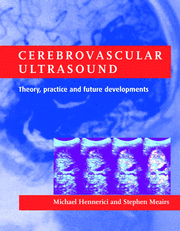Book contents
- Frontmatter
- Dedication
- Contents
- List of contributors
- Preface
- PART I ULTRASOUND PHYSICS, TECHNOLOGY AND HEMODYNAMICS
- PART II CLINICAL CEREBROVASCULAR ULTRASOUND
- (i) Atherosclerosis: pathogenesis, early assessment and follow-up with ultrasound
- (ii) Extracranial cerebrovascular applications
- 14 Carotid and vertebral arteries
- 15 Quantitation and grading of carotid artery stenosis
- 16 Carotid artery pseudo-occlusion
- 17 Standardization of carotid stenosis investigation
- (iii) Intracranial cerebrovascular applications
- PART III NEW AND FUTURE DEVELOPMENTS
- Index
14 - Carotid and vertebral arteries
from (ii) - Extracranial cerebrovascular applications
Published online by Cambridge University Press: 05 July 2014
- Frontmatter
- Dedication
- Contents
- List of contributors
- Preface
- PART I ULTRASOUND PHYSICS, TECHNOLOGY AND HEMODYNAMICS
- PART II CLINICAL CEREBROVASCULAR ULTRASOUND
- (i) Atherosclerosis: pathogenesis, early assessment and follow-up with ultrasound
- (ii) Extracranial cerebrovascular applications
- 14 Carotid and vertebral arteries
- 15 Quantitation and grading of carotid artery stenosis
- 16 Carotid artery pseudo-occlusion
- 17 Standardization of carotid stenosis investigation
- (iii) Intracranial cerebrovascular applications
- PART III NEW AND FUTURE DEVELOPMENTS
- Index
Summary
Doppler sonography
Doppler sonography of the extracranial carotid and vertebral arteries was introduced as a routine clinical method in the mid-1970s, some years later, ultrasound imaging techniques became available. Early studies using continuouswave (CW) Doppler sonography established criteria for normal and abnormal hemodynamic conditions in the carotid and vertebral artery systems which were later validated in numerous other investigations (Arbeille et al., 1984; Hennerici et al., 1981a; Pourcelot, 1974; von Reutern et al., 1976; Trockel et al., 1984). Due to the reliability of these criteria and the inexpensive technology, CW-Doppler sonography (‘pencil Doppler’) is still used in many neurovascular laboratories regardless of the immediate availability of modern sonographic imaging devices with integrated pulsed wave (PW) Doppler systems. However, since recording of the Doppler flow signals as an analogue envelope curve had significant disadvantages, display of the Doppler frequency spectrum became the preferred method of documentation providing several parameters for hemodynamic analysis (Jacobs et al., 1985; Johnston et al., 1986; Rittgers et al., 1983; Robinson et al., 1988; Taylor & Strandness, 1987; Zwiebel & Knighton, 1990).
Carotid artery
The different extracranial arteries are characterized by distinct acoustic Doppler signals and Doppler spectra, respectively, depending on whether they supply brain tissue with low vascular resistance (internal carotid artery, vertebral artery), muscles and skin with high peripheral resistance (external carotid artery, subclavian artery), or both (common carotid artery) (Fig. 14.1).
- Type
- Chapter
- Information
- Cerebrovascular UltrasoundTheory, Practice and Future Developments, pp. 193 - 222Publisher: Cambridge University PressPrint publication year: 2001
- 2
- Cited by



